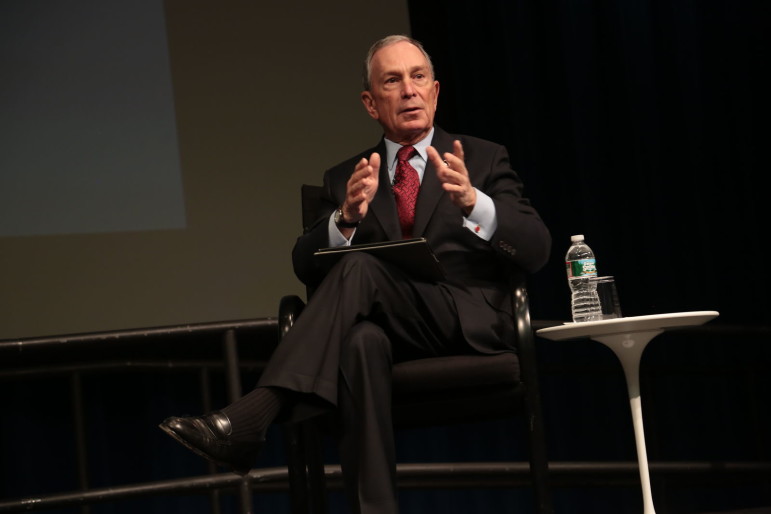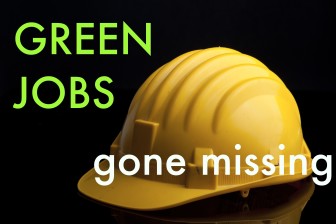
Ed Reed/City Hall
In 2009, then-Mayor Bloomberg announced 30 initiatives to create 13,000 jobs over the next decade. The city says the definition of a green job has changed so rapidly that there's no way to track whether that is occurring.
The Osborne Association has a multi-pronged approach to help formerly incarcerated people adjust to life on the outside—a big part of this is job placement. In 2009, a great way to do this seemed to be training people to enter the green job market, said John Valverde, the association’s executive vice president.
“At the time, it was a hot topic,” Valverde says. “We believed that there would be opportunity, particularly because this sector traditionally has been justice friendly,” he said, referring to green employers’ track record of hiring applicants with a criminal history. “We were very committed to this workforce development program,” he says.
Indeed, at that time, the prospect of a flourishing green job sector was hard to ignore. Money poured into state energy-efficiency programs from the American Recovery and Reinvestment Act of 2009 (also known as the federal stimulus program) that emphasized developing a green economy. A labor union, Local 10, was even created to represent weatherization workers.
Presidential candidate Barack Obama promised to create 5 million green jobs via a ten-year, $150 billion investment plan that would focus on advancing a clean-energy economy. One of his early moves as president was to allocate $500 million in green-job training programs, aiming to reach about 125,000 people.
Obama’s national call for green jobs was echoed on the local and state level. The next year, in 2009, then-Mayor Michael Bloomberg announced a 30-initiative program that would create 13,000 jobs over the next decade. “We hear a lot about the potential of green jobs as a driver of future economic growth, but often the rhetoric is not matched with a real plan to capitalize on opportunities,” the mayor said at the time. “The initiatives we’re announcing today will take advantage of the progressive sustainability practices we continue to put in place in New York City, and will create real green jobs by attracting and growing green businesses and helping the city’s workforce be prepared to meet the demand for green skill-specific jobs.”
And, of course, on the state level, the 2009 Green Jobs/Green New York Bill promised to create thousands of jobs over the next five years. “The Green Jobs Green New York program will create 14,000 good-paying jobs,” said then-State Senator Eric Schneiderman. And, he added, it would “enable New Yorkers who are looking for work to secure the kind of employment in energy efficiency, that really has a future.”
These would be solid, steady middle-class careers, politicians promised, and not the kind that required high levels of education—the type of career manufacturing provided in its heyday. The term “green-collar job” was coined by then-Obama administration “green job czar” Van Jones. The term took off.
The burgeoning new sector was hard to ignore, particularly to those in the business of job placement or job training—or those in the market for a new career.
However, seven years later, the sector has failed to materialize, at least not in the form promised.
In fact, the Federal Bureau of Labor Statistics stopped tracking green jobs as a separate category in 2012. Obama’s 2009 green job initiative fell far short of his expectations: Rather than 125,000 trainees, the program produced about 50,000. Roughly 1 in 10 found employment, according to an audit by the Department of Labor’s inspector general.
New York State’s Green Jobs-Green New York program reports the creation of a mere 1,100 jobs. And the city’s Economic Development Corporation told City Limits that it was not possible to track the number of jobs created by Bloomberg’s 30 proposed initiatives because the definition of a green job is so rapidly changing.
Those who have tracked the green-job field in New York City say they’ve seen a greening of existing jobs more so than a flourishing new sector. Having green skills became more important for construction workers, building managers, and custodians, for example.
“People who are the custodians of schools, or the superintendents of apartment buildings, they’re now doing their jobs in a more energy efficient way. But it’s the same person who’s been retrained to do things differently,” says Ronnie Kauder from the New York City Labor Market Information Service, who authored a 2012 report on green jobs in New York City.
This is not to say that green skills aren’t important for job seekers today. James Eleby recently went through a green-jobs training program at Solar One in Long Island City, Queens. Since 2009 Solar One has been one of the city’s top green-job training outfits. There he earned his Occupational Health Safety & Health certificate, which is needed for construction work; a building maintenance certificate; and a green energy certification.
“It was a broad scale of ways of saving energy,” Eleby says of the training he received.
Today Eleby makes artisanal furniture from reused materials at the Brooklyn-based company, Refoundry.
“This is the type of job that you want to bring home. You know what I mean? That you feel good about bringing home with you,” he says.
Not all green trainee stories are so positive. After serving 17 years in prison for assault, Johnny Parker, 47, was looking to find a place in the outside world. His career counselor at The Fortune Society, a non-profit organization that helps formerly incarcerated people, connected him with a green job-training program at Solar One. “I was so grateful,” Parker says of the opportunity. “It helped me stay busy, it helped me stay more productive on parole. The more information they gave me, it made me more reflective on what I want to do,” he says.
Solar One’s Green Workforce Training Program trains both job seekers and building maintenance staff in green-building operations and maintenance. They run courses in green construction, which includes solar-panel instillation, and the construction of green building envelopes.
While at Solar One, Parker became a strong believer of the green movement. He soaked in everything he learned about green technology and green buildings, and was excited to put his newfound passion and skills to work.
“I want to do something that makes a difference,” he says.
Since graduating over a year ago he has been searching for a green job, “There’s not an abundance of them,” he says.
He’s out of work at the moment, though he recently finished a construction gig in Chinatown. He was happy to have the work, but disappointed by the amount of waste he saw being created—this was not only not a green construction job, it was “un-green.”
Solar One says it does what it can to keep up with the evolving field. Right now that means focusing on its namesake energy source. “Solar has really taken off in New York State,” says Esther Siskind, Director of Programs at Solar One, of the organization’s decision to train students on solar panel installation and maintenance. “Governor Cuomo is investing a billion dollars in the solar industry,” she says.
Parker doesn’t regret his training at Solar One. If anything, he’s looking for a way to get back there. If there were a new training program he would be the first to sign up, he says, and is always looking to see if a job opens up at the organization itself. He thinks, too, that the skills he learned in green construction will make him a more competitive candidate, even if the job at hand doesn’t require them.
In some ways, Parker’s experience is similar to what Osborne was seeing its green job training graduates go through: Some of the skills they learned were useful in the field, but the field wasn’t a new sector of “green construction,” or “green building maintenance,” but rather a somewhat evolved field of construction and maintenance.
When the federal stimulus money dried up, a lot of the programs Osborne had been placing trainees in shut down, Valverde says. He decided that the so-called green sector wasn’t the best way to prepare trainees for the workforce—though some of the same skills are taught in current programs. “We kind of moved in the direction of moving that conversation into all of our work,” says Valverde.
In 2013, Osborne broadened the scope of the Green Career Center to include a wider array of trainings. Today, it is just the Career Center.
This series was produced by members of the fall 2015 urban investigative reporting course at the CUNY Graduate School of Journalism.









